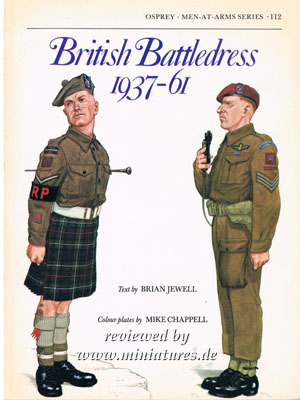British Battledress 1937–61
Osprey Men-At-Arms Series 112

In the 1930s the War Office grew increasingly aware of the need for a new and more rational combat dress, and by 1937 the design for what would become known as ‘Battledress‘ was complete. Though the change in uniform was initially disappointing to the British soldiers, the new battledress served its purpose well, clothing the servicemen for more than 25 years with reasonable warmth and convenience. Complete with a wealth of photographs, diagrams and colour plates, this book offers a history of British battledress up to 1961, detailing its evolution in design, materials, sizes and applied insignia.
Inhalt
- Titel: British Battledress 1937–61
- Epoche: 1937–1961
- Typ: Uniformkunde
- Autor: Brian Jewell
- Illustrator: Mike Chappell
- Format: 40-seitiges Taschenbuch
- Sprache: Englisch
- Verlag: Osprey Publishing, London, England
- ISBN: 0850453879
- Publiziert: 1981
Kapitel
- Introduction
- The Arrival of Battledress
- Evolution in Design
- Materials and Sizes
- Departures from Basic
- Applied Insignia
- The Plates
- Despatch Rider, Royal Signals; UK, 1941
- Flight Sergeant, Royal Air Force; UK 1942
- Lance Corporal, Kent Home Guard; UK, 1941
- Officer Cadet, 148th Independent Infantry Brigade; Wrotham, Kent, 1942
- Sergeant, Reconnaissance Corps; UK, 1942
- Staff Colonel, Northern Command; UK, 1942
- Private, 155th Infantry Brigade; Scotland, 1943
- Private, No. 2 Commando; UK, 1943
- Sergeant, Glider Pilot Regiment, 1st Airborne Division; UK, 1944
- Lance Corporal, 2nd Bn. Seaforth Highlanders, 51st Highland Division; UK, early 1944
- Major-General, 52nd (Lowland) Division; Low Countries, 1944
- Private, 7th/9th Royal Scots, 52nd (Lowland) Division; UK, early 1944
- Corporal, Queen‘s Own Rifles of Canada; France, 1944
- Platoon Sergeant, 1st Czech Armoured Brigade; France, winter 1944
- Captain, 2nd Bn. King‘s Royal Rifle Corps; Italy 1943
- Corporal, Royal Air Force, attached XXX Corps; France, 1944
- Private, 1st Belgian Brigade ‘Piron‘; North-West Europe, 1944
- Major, Belgian 16th Fusilier Battalion; Germany, March 1945
- Private, Netherlands Brigade ‘Prinses Irene‘; North-West Europe, 1944
- Lieutenant, Polish Carpathian Lancers; Italy, summer 1946
- Sergeant, Royal Engineers, 50th Division; Berlin, 1946
- Inspector of Police, Control Commission; Germany 1946–47
- Corporal, Royal Marines; UK, 1950s
- Colour Sergeant, 1st Bn. Royal Fusiliers; Korea, 1952–53
- Major, Royal Army Medical Corps; Scotland, 1950
- Lance Corporal, Gloucestershire Regiment; UK, 1961
Brian Jewells Buch über den britischen Battledress ist eine exzellente Quelle für Wargamer und Figurenmaler, die sich für die britische Armee des Zweiten Weltkriegs und des frühen Kalten Krieges interessieren. Die hervorragenden Illustrationen von Mike Chappell zeigen die Battledress-Uniform in unterschiedlichen Farbtönen von Khaki Drab bis Olive Drab. Vierfarbige Uniformdarstellungen liefern ausgezeichnete Farbreferenzen für Maler, die Mike Chappells schöne Auswahl ungesättigter Farben an eigenen Figuren der britischen Infanterie anwenden möchten.